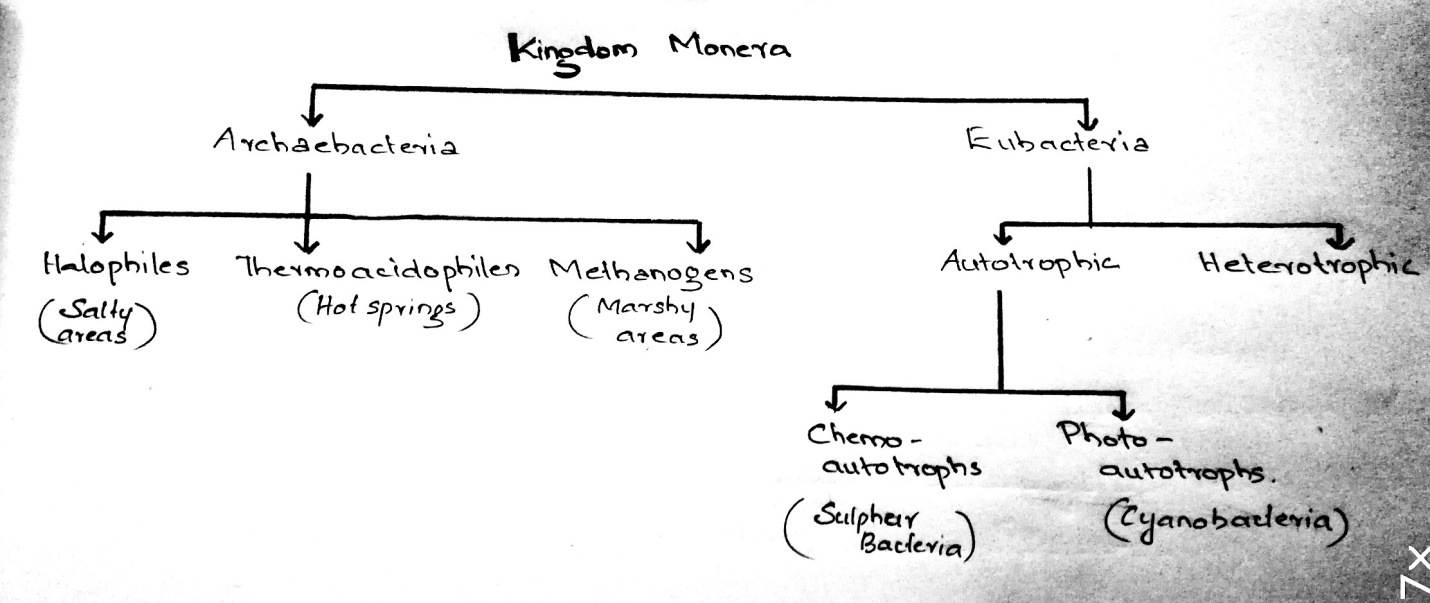Kingdom monera consists of prokaryotic organisms. Bacteria are the sole members of this group. They constitute the most abundant and microorganisms on earth. Even a single gram of soil contains nearly 40 million bacterial cells. They are found anywhere and everywhere. They can exist even in extreme conditions, where no other organism can survive. They are found at extreme high temperatures such as hotsprings (45C to 90C), deserts (-4C to 38C), snow (0C), and deep oceans. They are also found to survive as parasites in the body of other organisms.
Bacteria: Nutrition
Most of the bacteria are autotrophic. They can synthesisze their own food (like plants). They may either be phototropic autotrophs (produce food using sunlight, water and oxygen) or chemosynthetic autotrophs (produce food from inorganic raw materials). Chemosynthetic bacteria are found in places where sunlight is not available, like very deep oceans.
Majority of bacteria are heterotrophs. They obtain food from other organisms (live or dead). Most typical examples are parasites (depends on the host organism for food) and saprophytes (feeds on dead organisms).
Bacteria: Reproduction
They reproduce mainly through fission. Spore formation is also used for reproduction under unfavourable conditions. Sexual reproduction takes place through conjugation.
Bacteria: Classification
Bacteria are generally classified based on their shape.
Coccus – spherical shape
Bacillus – rod shaped
Vibrium – comma shaped
Spirillum – spiral shaped e.g. Anabaena spiroides
Kingdom monera is classified into two groups for taxonomical studies – Eubacteria and Archaebacteria.

Archaebacteria
Archaebacteria differs from other bacteria in having a different cell wall structure (made od peptidoglycan) that enable them to survive harsh environments. Therefore, they are usually found in very extreme habitatas.
Bacteria found in extreme salty areas are called Halophiles. Those found in hot springs are known as thermoacidophiles. Bacteria found in marshy areas are called mathanogens. (e.g. Methanobacterium ruminatium). Methanogens are also found in the gut of ruminant animals (cow and buffaloes). Thus the dung of these animals can be used to prepare methane gas.
Eubacteria
Eubacteria or ‘true bacteria’ differs from archaebacteria in having a rigid cell wall composed of polysaccharides and protein. Motile eukaryotes possess a flagellum. They may be autotrophic or heterotrophic in nutrition.
Cyanobacteria (blue-green algae) are photosynthetic autotrophs. They contain chlorophyll like plants. They live either in unicellular, colonial or filamentous form, and can be found in marine, freshwater or terrestrial habitats. When they are living in colony, they will secrete a gelatin substance that forms a sheath around the colony. They can survive in polluted waters, and thus can be seen as algal blooms. Certain cyanobacteria like Nostoc and Anabena have the ability to fix atmospheric nitrogen in specialized cells in the colony known as heterocycts. They are commonly found in the root nodules of leguminous plants.
Chemosynthetic bacteria decompose inorganic compounds like nitrates and ammonia to produce energy which can be used for the production of ATP. Nitrogen is released back into the environment, which can be used to produce more compounds of Nitrogen. Thus, they are involved in the biogeochemical cycles of nutrients such as nitrogen, sulphur and phosphorous.
Heterotrophic bacteria are mostly decomposers, and are the most numerous among other bacteria. They can create both beneficial and harmful impacts on human affairs. Beneficial bacteria includes those which are used in making curd from milk, antibiotics production and acts as nitrogen fixing agents in the root nodules of leguminous plants. Harmful bacteria include the disease causing pathogens. Cholera, tetanus, citrus canker etc. are some of the most known diseases caused by bacteria.
Mycoplasma is the smallest living organism known so far. They lack cell wall, and can live without oxygen. They are also pathogenic to plants and animals.